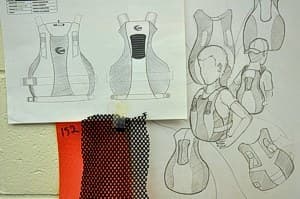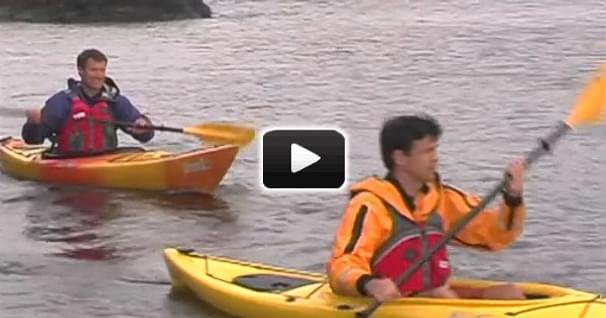PFDs: Innovation & Overview
By Tom Watson
Before you go gathering up your sketch pencils and drawing pad or firing up your CAD program, know that the route to creating and introducing an approved PFD is a long, arduous crossing against the gale-force winds of governmental bureaucracy and rip-tides of certification processes.
Jeff Beck, won the second competition offered in 2010 with his rash-guard shirt design that is now being manufactured and sold by Quatic. It features a built-in inflatable bladder and has already entered the mainstream PFD market arena. Beck says the design challenges in this country are "old school" and issues such as which fabrics to use and what colors are extremely costly and there are no assurances that it will work when you are finished.

Lili Colby, who co-owns MTI Adventurewear and is also a member of the panel of judges for this year's competition, says even changing the color of a life jacket can be considered an "innovation" because of the strict re-certification costs associated with such changes. Everyone agrees that the process takes many years and thousands upon thousands of dollars to successfully introduce a new and approved PFD onto the consumer marketplace.
Still the competition offers a hefty start-up prize for out-of-the-box thinkers and if even if the money is a feeble grubstake in a megabuck investment and commitment process, the promotion of the competition does draw attention to the need to wear a life jacket, so in that regard the ultimate reward is priceless.
The second major PFD news event happened on October 22, 2014, when the final rule that removes the current PFD Type codes in Federal Regulations went into effect. While the TYPE I-V category designations will no longer be used, the regulations regarding the number and kinds of PFD required on vessels and other watercraft will remain the same, but with new "terminology used to refer to approved PFDs". When developed and finalized, those changes are intended to make safety and use information more easily understood by the public. New wording, says the USCG, will also focus on "more harmonization of our regulations with PFD requirements in Canada and other countries."
Currently none of the details of what that information will entail or how it will be conveyed on new labels has yet been determined - it may be three or four years before all PFDs carry the new labeling information. Existing labels are grandfathered in.
Much of the best information on how to use a life jacket properly appears within the "Think Safe" brochures currently required to be attached to every approved PFD sold in America. One of the changes proposed in the new ruling is to provide more user-friendly descriptive information right on the label attached to each PFD. That information will include the specific uses of that particular PFD so the wearer can better determine the best device to use for the water activities they intend to pursue.
TYPES OF PFDs…
History tells us that in 870 an Assyrian King had his army use inflatable animal skins to cross a moat. It is perhaps the first recorded use of Mankind's reliance on a personal flotation device. Twenty-five hundred years later a Frenchman fabricated the first lifejacket buoyed up by cork. In 1912, an inflatable ring was invented to keep the wearer's head out of the water.
Today, both buoyancy (the force in pounds needed to keep a person's head and chin afloat above water - usually only 7-12 pounds) and intended use are two key criteria to consider when determining which type of life jacket to wear.
Other factors affecting buoyancy include the wearer's body weight and fat content, lung size, other clothing worn and water conditions. Ironically, the more physically fit you are, the more buoyancy or lift you will need!
Today there are three categories of PFDs:
- Inherently Buoyant - filled with either Gaia (an organic nitric compound); Kapok (a water-resistant fluffy fiber surrounding the seeds of the kapok tree); or PVC (polyvinyl) which is the most commonly used foam in PVCs.
- Inflatable - These tend to be for more specialized activities and can be inflated either automatically (water-activated triggering mechanisms) or manually (pulling a ripcord to activate a CO2 canister or using an oral inflation tube)
- Hybrid - A combination of foam panels and an inflatable bladder to provide buoyancy (amounts of minimum buoyancy varies by type classification of a hybrid).
PFDs are currently classified into five use types:
- TYPE I - Off-Shore Life Jackets: minimum buoyancy: 22 pounds; intended for rough, remote waters, rescue not immediate, bulky, usually turn unconscious wearer face up;
- TYPE II - Near-Shore Vests: minimum buoyancy: 15.5 pounds; calmer, inland waters, intended for fast rescue, tend to be less bulky than Type I. Not intended for extended duration in water; may turn some unconscious wearers face up;
- TYPE III - Flotation Aids: minimum buoyancy: 15.5 pound; quick rescue, not intended for survival in rough water, may require wearer to consciously tilt head back to keep face out of water; generally used by paddlers and most water-sport enthusiasts (see also Type V below);
- TYPE IV - Throwable Devices: minimum buoyancy: 16.5 pounds/Ring buoys, 18.0 pounds/boat cushions, to be used/thrown for buoyancy aid in calm, inland and high traffic areas with help nearby. Not for unconscious victims; non-swimmers, children;
- TYPE V - Special-Use Devices: minimum buoyancy: 15.5 - 22.0 pounds, specialized activities or conditions and used according to activities specifically cited on label, used for kayaking, waterskiing, white-water rafting, also includes deck suits and hybrid vests.
SIZING & FIT…
Although quite obvious, it can never be overstated: in order for a PFD/life jacket to be effective you MUST be wearing it!
Most people are more likely to wear one if it is comfortable and fits properly. Two important factors when buying life jackets for adults and kids are: 1) kids should not wear "adult" life jackets 2) kids sizes are determined by weight, not torso size/measurement as they are for adults.
Proper sizing for children is based on the following weight ranges:
• Infant: 8-30 pounds | • Child: 30-50 pounds | • Youth: 50-90 pounds
On children, a proper-fitting life jacket should not ride up more than a couple of inches when you grab each shoulder strap and lift the child. Many children's life jackets also utilize a crotch strap to help keep the PFD from sliding up. A child's device should also have a grab strap to enable a rescuer to quickly and easily grab onto to lift the wearer from the water.
For adults, it's important that your PFD fit your body snuggly - like a glove. This doesn't always work when the wearer's stomach is larger than their chest. However, when all the straps are adjusted, starting at the waist and moving up the jacket, tightening as you go, the jacket shouldn't shift or ride up while being worn.
Some manufacturers suggest the "touchdown" test. While standing, put on the life jacket, cinch it up and then stretch your arms upward as if you were a ref' signaling a touchdown. A proper-fitting PFD should not slip up over your chin or nose.
That snug fit must be coupled with comfort and easy maneuverability to enable the wearer to move his/her arms, torso - one's whole body - freely and without restriction. One should also consider deeper cut necks, large arm holes and the width of shoulder straps for better fit. Make sure, too, that it doesn't rub or chafe any part of your body. Typically it's more about the straps, and not foam placement, that enables you to make necessary adjustments for a proper fit.
Lastly, take an opportunity to test your PFD's functioning in different water conditions, or when wearing different types/layers of paddling clothing.
PFD CARE & MAINTENANCE…
Typically a manufacturer will include maintenance information on a tag attached to the product. Such information/instructions are particularly critical for any specialty PFD or inflatable with triggering mechanisms and components.General Use, Care and maintenance tips include:
- Check for damage due to holes, rips, tears;
- Check integrity of zippers, seams, clips, etc.;
- Check for shrinkage, mildew, water-logging, faded material;
- Don't use it as a pad, cushion, boat bumper or other compression applications;
- Don't put sharp or heavy objects in pockets;
- On inflatables, check the indicator light, CO2 cartridge threads, etc.;
- Rinse with fresh water after use;
- Don't wash with harsh detergents or dry clean;
- Drip dry. Don't use clothes dryer; radiators or other similar heat sources;
- Don't leave your PFD stored in your boat for a long period;
- Practice throwing a TYPE IV device (underhand is typically easier);
- Dispose of old, useless PFDs by cutting them up and disposing of them properly.
And despite the frustration BOATU.S/PFDMA-competition winners Adam Malcom (2006) and Jeff Beck (2011) commented on in regards to jumping through all the certification hoops; the astronomical costs, and the multi-year processes that stand as hurdles towards the advancement of PFDs, the ultimate goal is still to create a device that is more comfortable and most appealing to the wearer in fit, style and overall comfort - and (hopefully!) most likely to be worn whenever the wearer ventures out onto the water.
Most PFD/life jacket brands have excellent websites with a wealth of information on selecting the proper life jacket. Be safe; have fun - and wear your lifejacket!
NOTE: For an overview of PFD tests conducted by BOATUS, go to: http://www.boatus.org/findings/50/
Tom Watson is an avid sea kayaker and freelance writer. For more of Tom's paddling tips and gear reviews go to his website:www.wavetameradventures.com He has written 2 books, "Kids Gone Paddlin" and "How to Think Like A Survivor" that are available on Amazon.com.
Related Articles
The following is an excerpt from World Champion, Ken Whiting's new book, "Rolling a Kayak" …
What's the best way to quiet a novice paddling class? Mention the "Eskimo Roll." Nothing worries…
I'm sure you'll be happy to hear that kayaking is a remarkably safe sport. In fact, compared to most…
Hi, I'm Robert Stehlik with Blue Planet Surf. I wanted to talk a little bit about moving around on the…



